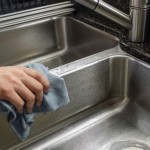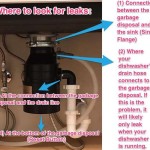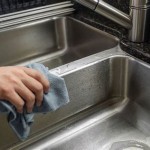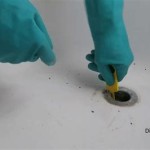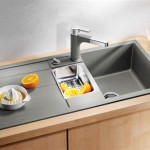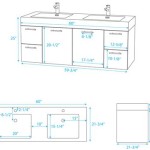How to Fix a Kitchen Sink Drain
A clogged kitchen sink drain is a common household problem. Food particles, grease, and other debris can accumulate in the drainpipe, restricting water flow and eventually leading to a complete blockage. Addressing the issue promptly can prevent further complications and costly plumbing repairs. This article provides a comprehensive guide to diagnosing and resolving common kitchen sink drain problems.
Identifying the Cause of the Clog
Before attempting any repairs, it is crucial to determine the likely cause of the clog. Several factors can contribute to a blocked kitchen sink drain, each requiring a specific solution. Common culprits include:
*Food Scraps:
Small food particles, such as coffee grounds, rice, and pasta, can accumulate in the drainpipe and form a dense blockage. These materials often expand when wet, further exacerbating the problem. *Grease and Oils:
Fats, oils, and grease solidify as they cool, adhering to the inside of the drainpipe and trapping other debris. Over time, this buildup can significantly restrict water flow. *Hair:
While more common in bathroom drains, hair can also find its way into kitchen sink drains, especially if food preparation involves handling meat or poultry. Hair tangles easily and binds with grease and other materials, forming a stubborn clog. *Soap Scum:
The combination of soap and hard water can create a sticky residue that coats the drainpipe, attracting debris and narrowing the passage. *Foreign Objects:
Inadvertently dropping small objects, such as silverware, bottle caps, or small toys, into the drain can cause an immediate blockage. *Mineral Buildup:
In areas with hard water, mineral deposits can accumulate inside the drainpipe over time, reducing the diameter of the pipe and restricting water flow. *Pipe Issues:
In older homes, corroded or damaged pipes can contribute to clogs. Rust and scale can flake off the inside of the pipe, obstructing the flow of water. Additionally, misaligned or poorly installed pipes may be more prone to blockages.Observing the symptoms, such as the rate at which water drains and any unusual noises coming from the drain, can help narrow down the potential causes. A slow draining sink often indicates a partial blockage, while a completely blocked sink suggests a more significant obstruction.
Simple Solutions for Minor Clogs
For minor blockages, several simple solutions can be attempted before resorting to more invasive methods:
*Boiling Water:
Pouring a kettle of boiling water down the drain can sometimes dissolve grease and loosen other debris. This method is most effective for clogs caused by grease or soap scum. It's vital to exercise caution when handling boiling water to avoid burns. Also avoid this method is if your sink, pipes, or drain fittings are PVC as boiling water can damage the PVC material. *Baking Soda and Vinegar:
Combining baking soda and vinegar creates a chemical reaction that can help break down clogs. Pour one cup of baking soda down the drain, followed by one cup of vinegar. Let the mixture fizz for 30 minutes, then flush with hot water. The fizzing action helps to dislodge debris and clean the drainpipe. *Dish Soap and Hot Water:
Squirt a generous amount of dish soap down the drain, followed by hot water. The soap can help to lubricate the drainpipe and loosen grease and other sticky substances. Let it sit for 15-20 minutes before flushing with hot water. *Plunger:
A standard cup plunger can often dislodge minor clogs. Ensure there is enough water in the sink to cover the cup of the plunger. Create a tight seal around the drain opening and plunge vigorously up and down for several minutes. Remove the plunger and check if the water drains freely. Repeat as needed. *Wet/Dry Vacuum:
A wet/dry vacuum can be used to suck out debris from the drain. Remove the drain strainer and position the vacuum hose over the drain opening. Create a tight seal and turn on the vacuum to extract any loose debris. Ensure the vacuum is designed for wet use before attempting this method.If none of these methods are successful, the clog may be more stubborn and require a different approach.
Using a Drain Snake or Auger
For more persistent clogs, a drain snake or auger can be used to physically break up or remove the blockage. There are two main types of drain snakes: manual and powered.
*Manual Drain Snake:
A manual drain snake consists of a flexible metal cable with a corkscrew or auger tip. Insert the snake into the drain opening and feed it down the drainpipe until you encounter resistance. Rotate the handle to advance the snake through the clog. Once you feel the clog break up or you are able to push the snake past it, retract the snake, removing any debris that is attached. Flush the drain with hot water to ensure the clog is completely cleared. *Powered Drain Auger:
A powered drain auger is similar to a manual drain snake, but it is powered by an electric motor. This type of auger is more effective for clearing tougher clogs and can reach further into the drainpipe. Exercise caution when using a powered drain auger to avoid damaging the drainpipe. Follow the manufacturer's instructions carefully.When using a drain snake, it is important to wear gloves to protect your hands from bacteria and debris. Work slowly and carefully to avoid damaging the drainpipe. If you are unable to clear the clog with a drain snake, it may be necessary to disassemble the drainpipe to access the blockage.
Disassembling and Cleaning the Drainpipe
If the clog is located in the P-trap or other accessible parts of the drainpipe, disassembling and cleaning the pipe may be necessary. The P-trap is the curved section of pipe located under the sink. It is designed to trap debris and prevent sewer gases from entering the home.
1.Gather Supplies:
Place a bucket under the P-trap to catch any water or debris. Gather a pair of pliers, a wrench, and a screwdriver, as needed. 2.Loosen the Connections:
Carefully loosen the slip nuts that connect the P-trap to the drainpipe. If the nuts are difficult to loosen, use pliers or a wrench. Avoid overtightening the nuts, as this can damage the plastic or metal. 3.Remove the P-Trap:
Once the nuts are loose, carefully remove the P-trap from the drainpipe. Be prepared for water and debris to spill out. 4.Clean the P-Trap:
Empty the P-trap into the bucket and thoroughly clean it with water and a brush. Remove any accumulated debris, such as food scraps, grease, or hair. 5.Inspect the Drainpipe:
Inspect the drainpipe leading from the sink for any signs of blockage. Use a drain snake or a wire coat hanger to remove any debris. 6.Reassemble the Drainpipe:
Once the P-trap and drainpipe are clean, reassemble the drainpipe, tightening the slip nuts securely. Avoid overtightening. 7.Test the Drain:
Run water into the sink to test the drain. Check for leaks around the connections. If there are any leaks, tighten the slip nuts further. If the leaks persist, the fittings or the P-trap itself may need to be replaced.When disassembling the drainpipe, it is important to take pictures or make notes of the order in which the parts are connected. This will make it easier to reassemble the drainpipe correctly. Also, ensure that all washers and seals are properly positioned to prevent leaks.
Preventing Future Clogs
Preventing clogs is always preferable to having to fix them. Implementing a few simple habits can significantly reduce the likelihood of future blockages:
*Use a Drain Strainer:
A drain strainer is a simple and inexpensive device that fits into the drain opening and catches food scraps and other debris. Empty the strainer regularly to prevent it from overflowing. *Avoid Pouring Grease Down the Drain:
Never pour grease, oils, or fats down the drain. These substances solidify as they cool and can cause significant blockages. Dispose of grease in a separate container, such as an empty jar or can, and discard it in the trash. *Flush with Hot Water After Each Use:
After washing dishes or preparing food, flush the drain with hot water for several minutes. This helps to wash away any remaining debris and prevent buildup. *Avoid Disposing of Certain Foods Down the Drain:
Certain foods, such as coffee grounds, rice, pasta, and eggshells, are more likely to cause clogs than others. Avoid disposing of these foods down the drain. *Periodically Clean the Drain with Baking Soda and Vinegar:
As a preventative measure, pour baking soda and vinegar down the drain every few weeks. This helps to break down any accumulated debris and keep the drainpipe clear. *Consider Enzyme Drain Cleaners:
Enzyme drain cleaners use natural enzymes to break down organic matter, such as food scraps and grease. These cleaners are a more environmentally friendly alternative to chemical drain cleaners. Follow the manufacturer's instructions carefully.By adopting these preventative measures, homeowners can minimize the risk of kitchen sink drain clogs and keep their plumbing system functioning smoothly.

4 Ways To Fix Your Kitchen Sink Wikihow

Kitchen Sink Strainer Fail No Clue What Happened

How To Replace A Kitchen Sink Drain Strainer Repair Leak

How To Replace A Kitchen Sink Drain

How To Replace A Kitchen Sink Basket Strainer Diy Family Handyman

How To Replace A Kitchen Sink Strainer Hard Remove Old Parts Youtube

How To Unclog A Kitchen Sink Drain

Quick Tip For A Kitchen Sink Drain That Is Leaking

How To Fix A Kitchen Sink Not Draining Bunnings Work Community

How To Replace A Kitchen Sink Strainer
See Also
